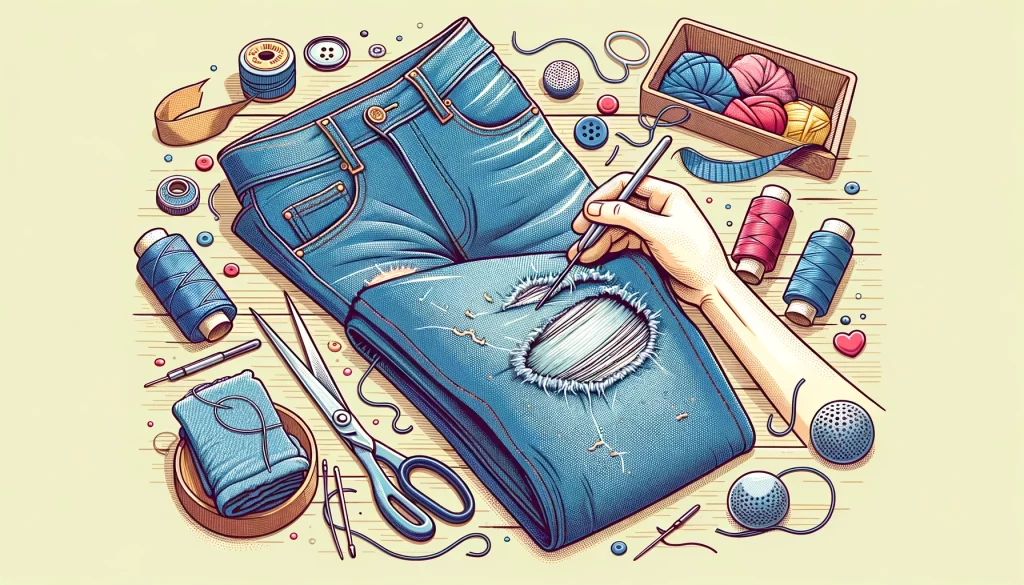Don’t let a pesky tear put an end to your favorite jeans’ journey. With a few straightforward techniques, you can easily restore them to their former glory and even add a touch of personal flair. Discover how to transform your denim and explore unique patches at inktasticmerch.com for an upgrade that makes a statement.
Have you ever discovered one of your favorite pairs of jeans with an unfortunate tear, leaving you to think it might be time to say goodbye? You’re certainly not the only one to experience this frustration. Many of us encounter the sadness of finding rips in our beloved denim, wondering if they can ever be revived. But there’s hope! Fixing ripped jeans is not only doable; it’s also a simple skill that anyone can acquire. In this article, we’ll show you various ways to patch up torn jeans — from easy sewing techniques to no-sew hacks that will effortlessly restore your denim to its former glory.
Want to give those jeans a fresh start? Continue reading!
Key Takeaways
- Repairing jeans instead of discarding them saves money and benefits the environment by cutting down on waste.
- You have multiple options for fixing ripped denim, such as hand sewing, machine darning, fabric mending tape, or iron-on patches for a no-sew solution.
- Properly preparing your jeans before mending, like trimming frayed edges and washing them as instructed, ensures a smoother repair process and using materials that complement your denim is key.
- Introducing unique features like decorative patches or embroidery allows you to personalize your repaired jeans, turning any damage into a fashion-forward statement.
- Reinforcing areas prone to wear and tear in your jeans extends their life, keeps them out of landfills, and prevents future rips.
Exploring the Different Methods to Fix Ripped Jeans

Unlock a range of methods to rejuvenate your cherished denim, from the traditional art of sewing to creative no-sew remedies. Dive into DIY jean repair and discover the ideal approach that matches both your skill level and personal flair.
Sewing With Thread
Sewing with thread presents a reliable way to mend ripped jeans, offering both strength and adaptability. For minor holes, using an embroidery needle with at least four strands of white thread can produce a robust fix that seamlessly blends with the denim.
This approach not only mends the tear but also reinforces the fabric to avert future damage.
Darning with a sewing machine provides another effective solution for tackling denim repairs. Using a darning stitch allows for quick patching of larger areas, making it perfect for significant tears or delicate patches.
Repairing ripped jeans with this technique promises longevity and does its best to restore the garment’s original appearance. Whether stitching by hand or machine, choosing the appropriate yarn—such as embroidery thread for denim repair—is vital for achieving results that look professional and handle regular wear and washing cycles.
Using Fabric Mending Tape
Fabric mending tape offers a speedy fix for torn jeans without requiring extensive sewing expertise. Simply position the tape beneath the damaged section and apply heat, typically with an iron.
This heat-activated patch forms a durable bond with the fabric, effectively resisting further wear and tear. It’s particularly useful for reinforcing tears or adding strength to weakened areas of denim.
Pairing this method with additional repair techniques, such as sewing reinforcement or using interfacing, can deliver a more comprehensive solution to your denim repair challenges. The ease
The versatility of fabric adhesive makes it a go-to choice for DIY clothing repair enthusiasts aiming to prolong the life of their cherished jeans.
With careful application, individuals can seamlessly repair rips while preserving the original appearance and texture of their denim garments.
Patching With Spare Fabric
Transitioning from the straightforward use of fabric mending tape, patching with spare fabric offers a creative and lasting way to restore ripped denim. This method provides adaptability for covering extensive tears or holes, breathing new life into beloved jeans.
Choose a spare fabric piece that closely matches or complements your denim’s color and texture. Cut the fabric slightly larger than the tear to ensure complete coverage.
To secure the patch effectively, position it behind the tear and employ stitching techniques such as darning or straight stitches along the edges. For added durability, apply interfacing beneath the fabric before sewing, establishing an invisible reinforcement that strengthens the repair.
This technique not only mends your jeans but also imparts a personalized touch, making each pair uniquely yours.
No-sew Options
Iron-on patches provide a swift and straightforward solution for mending holes and tears in jeans, eliminating the need for sewing. Simply position the patch over the damaged area, apply heat with an iron, and secure it in place.
This no-sew method offers an easy repair solution accessible to anyone at home. It’s ideal for those lacking sewing skills or equipment but wishing to prolong their favorite jeans’ lifespan.
Embroidery stitches can creatively cover holes, while decorative clothing patches transform ripped denim into unique fashion pieces without sewing.
These techniques not only repair tears but also personalize your jeans, making them stand out with custom designs. For straightforward tears, no-sew tear mender provides a fabric-bonding alternative without stitching, ensuring both strength and flexibility in garment repairs.
Step-by-Step Guide to Repairing Ripped Denim

Explore our detailed guide to skillfully patch your beloved jeans and revitalize them with ease.
Preparing the Jeans
Preparation is a vital first step in the journey to restore torn denim. It creates a strong foundation for successful mending, ensuring your jeans are primed for patches or stitches. Here’s how to get started:
- Begin by laying the jeans flat on a sturdy surface, ensuring they are free of wrinkles or folds, as these could disrupt your repair efforts.
- Carefully trim frayed edges around the hole with sharp scissors for a clean working area, helping to prevent further damage.
- Reinforce tear-prone areas, like the crotch seam, by sewing around them or applying fabric mending tape for extra support.
- Wash and dry the jeans according to their care instructions before starting repairs. Clean fabric ensures that patches or stitches adhere well and last longer.
- Create distressed patches if you prefer a more lived-in look. Doing this in advance allows repairs to blend smoothly with the rest of your denim.
- Select materials that closely match the color and weight of your denim for a cohesive appearance.
a discreet repair job. Selecting the right threads or patches is essential to achieving a polished look for your repaired jeans.
Cutting Frayed Edges
Once your jeans are prepared, the next task is to tackle those pesky frayed edges. Trimming them ensures a cleaner surface for patching, resulting in stronger repair work. Here’s a guide to trimming fraying threads and prepping the denim for patching:
- Spread the torn jeans flat on a work surface. Ensure the area around the rip is smooth and wrinkle-free to avoid uneven cuts.
- Identify all frayed edges and stray threads near the tear. These can contribute to further unraveling if left unchecked.
- Choose sharp scissors for the task. Dull blades may tug on the denim fibers, causing more harm than good.
- Precisely trim away frayed edges and loose threads, cutting as close to the base as possible without removing excess fabric.
- Inspect around and inside the hole for any hidden frays or loose threads that might have been overlooked.
- Gently pull on the trimmed edges to ensure no loose threads remain. This action also highlights any spots needing further trimming.
- Maintain steady and controlled movements while cutting to avoid accidentally enlarging the hole.
- After removing any unwanted threads, validate your work to ensure a clean-edged hole with no frayed ends left behind.
Choosing a Patch
Selecting the appropriate patch is crucial for repairing torn denim, laying the groundwork for a resilient and eye-pleasing fix. From decorative patches to custom-cut pieces, these options will not only mend ripped jeans but also restore their strength.
- Consider the Material: Select a patch material that matches or complements your jeans. Denim patches are ideal for denim repairs as they share similar wear and fade characteristics over time.
- Size Matters: The patch should exceed the rip or hole slightly in size. This extra margin enables secure attachment without further stressing the damaged area.
- Color Coordination: Matching your patch’s color to your jeans makes the repair less noticeable. However, contrasting colors or patterns can highlight the repair as a bold fashion statement.
- Adhesive Options: Based on your method, decide between iron-on patches for an easy no-sew solution, or patches without adhesive for hand or machine sewing.
- Shape Your Patch: Rectangular or square patches are easiest to manage and apply. Nevertheless, don’t hesitate to cut shapes that align with your jeans’ contours or introduce a design element.
- Fabric Mending Glue: For an added layer of security, particularly around the edges, consider applying fabric mending glue in conjunction with sewing or ironing. This reinforces the bond, making it perfect for stress-prone areas.
Attaching the Patch
Attaching the patch is a vital step in bringing your favorite jeans back to life. This process demands precision in placement and sewing to guarantee longevity and a seamless finish.
- Position the patch: Place the denim patch behind the tear, ensuring it fully covers the hole with at least an inch of additional fabric around it for enhanced support. Align itto maintain the jeans’ original patterns and lines.
- Secure with pins: Position straight pins to hold the patch steadily from the front, preventing any shifting as you sew. Distribute the pins evenly around the torn area for a firm grip.
- Choose your thread: Opt for a thread color that matches your jeans for a subtle repair, or pick a contrasting shade for a more decorative appearance. A thicker thread is ideal for denim.
- Thread the needle: Use a sturdy, denim-friendly needle for hand stitching. Double the thread for added durability, but keep the length manageable to avoid tangles.
- Begin sewing: Start from the inside of the jeans to conceal the knot. Employ a simple running stitch or backstitch around the hole’s perimeter, roughly 1/8 to 1/4 inch from its edge, to secure the fabric layers.
- Reinforce with stitches across: For maximum durability, create X-shaped crosses over smaller holes or parallel lines over larger areas within your initial stitching boundaries.
- Tie off securely: Once you’ve completed the stitching and reinforcement, finish by tying off the thread inside the jeans with several knots to prevent unwinding.
- Trim excess fabric (optional): If any patch fabric extends beyond your stitches, carefully trim it back without cutting too close to the threads.
Finishing touches
Enhancing your repaired denim with the right finishing touches can boost its appearance and longevity. This stage is all about precision, from trimming frayed edges to incorporating decorative elements.
- Carefully trim frayed edges around the tear to prepare for a neat repair. This prevents further fraying and simplifies the repair process.
- Sew the rip using a method that mirrors the jeans’ original stitching style, if possible. A sewing machine provides precision, offering a secure and nearly invisible finish.
- Trim excess thread and material extending beyond the stitched area. This cleanup provides a polished finish to your repair.
- For more distressed areas, consider adding extra fabric patches for distinctive designs that add character to your jeans.
- Apply iron-on patches for a quick fix, ensuring they adhere firmly with the correct heat application.
- Decorate the patched area with embroidery or additional stitches for a creative twist, transforming your repair into a standout feature.
- For personalized touches, hand-stitch clean rips using techniques that enhance the garment’s artisanal appeal.
Tips and Tricks for Successful Jeans Repair

Mastering the skill of jean repair can transform your aged denim into stylish, durable attire; explore essential techniques for a flawless fix.
Matching thread color
Choosing the appropriate thread color is vital for a discreet jeans repair. Aim for a thread that closely resembles your denim’s hue, ensuring the repaired sections blend seamlessly with the original fabric, minimizing visibility.
For machine repairs, threading yourA sewing machine equipped with a color that closely matches your denim can make stitches virtually invisible, especially when performing an overcast stitch along frayed edges.
Utilizing thread color matching can greatly improve the visual appeal of your denim repairs. Whether you’re sewing by hand or using a machine, selecting a thread that matches enhances not only the durability but also preserves the beauty of your jeans.
Paying attention to detail in denim repair ensures that patched areas go unnoticed, ultimately prolonging the life of your beloved jeans through effective mending techniques.
Strengthening Common Wear Zones
Reinforcements in areas susceptible to tearing enable your jeans to endure more wear, thereby extending their lifespan. The crotch is particularly notorious for stress due to constant movement and is prone to sweat and bacteria accumulation.
To bolster denim in this vital section, repeatedly apply straight stitching across any gaps, creating a robust, reinforced patch. This approach repairs current damage while preventing future rips.
Applying patches to areas such as the knees or thighs provides another practical approach for denim repairs, adding an extra layer of strength. Choose patches that match the weight and flexibility of your jeans to retain comfort and ease of movement.
Using color-matched thread to sew these patches ensures the repair blends seamlessly into the garment. These techniques do more than merely patch holes; they fortify weak spots against future tears.
Washing and Drying Tips
Cleaning and drying jeans before any repair work is essential to ensure the fabric is in optimal condition. This process tightens the material, facilitating easier repairs and enhancing patch adhesion.
Always wash with cold water to minimize further shrinkage and potential damage. Post-wash, avoid twisting or wringing to protect the jeans’ shape.
Hang your jeans to air dry before storage to keep them fresh and prevent additional tears. It’s best to dry them away from direct sunlight and heat to prevent fading and weakening.
Instead, select a well-ventilated area for natural drying. This method not only maintains the integrity of repaired sections but also prolongs the overall lifespan of your jeans, aligning with sustainable clothing practices.
Conclusion
Mending torn jeans not only rejuvenates your cherished denim but also promotes sustainability by reducing waste. This guide provides various techniques, from stitching to no-sew solutions, allowing anyone to embark on this DIY venture.
Remember, repairing denim fortifies both the fabric and your bond with treasured pieces. Let’s embrace mending as a creative and eco-friendly fashion practice.
FAQs
1. Can I patch torn jeans without sewing?
Absolutely, iron-on patches or fabric glue offer no-sew solutions for mending torn jeans.
2. What material works best for patching jeans?
Denim or heavy cotton patches are ideal for durability and matching your jeans’ appearance.
3. How do I select the right color patch for my jeans?
Attempt to match the patch material to your jeans for a cohesive look, or choose a contrasting hue for a creative edge.
4. Can patched areas on my jeans be made less noticeable?
Employing a patch from similar denim and skillful stitching can reduce the visibility of repairs.
5. Are all types of jean tears repairable?
Most tears, particularly in non-stretch zones like knees or thighs, can be effectively mended if addressed promptly.
For more tips and creative ideas on sustainable fashion and clothing care, be sure to explore our Blog for a wealth of resources and inspiration.




